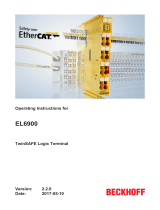
Leuze electronic Connector Unit MA 30 / MA 31 1
Leuze electronic Table of Contents
1 General Information.............................................................. 2
1.1 Explanation of symbols ............................................................................... 2
1.2 Declaration of Conformity ........................................................................... 2
2 Device Description................................................................ 3
2.1 Differences between MA 30 / MA 31 .......................................................... 3
2.2 Function of the MA 30/31............................................................................ 3
2.3 Addressing in the network........................................................................... 5
2.4 Control elements of the MA 30/31 .............................................................. 6
2.5 MA 30/31 as network master ...................................................................... 9
2.6 Service mode ............................................................................................ 10
2.7 Specifications............................................................................................ 12
2.8 Dimensioned drawings.............................................................................. 13
3 Connection .......................................................................... 14
3.1 Connecting the host interface ................................................................... 14
3.1.1 RS 485 interface: .................................................................................................... 14
3.1.2 RS 232 interface: .................................................................................................... 15
3.1.3 TTY interface:.......................................................................................................... 15
3.1.4 RS 422 interface: .................................................................................................... 16
3.2 Connecting the multiNet plus interface ..................................................... 16
3.3 Connecting the switching inputs ............................................................... 18
3.4 Connecting the switching outputs ............................................................. 19
3.5 Connecting the voltage supply.................................................................. 21
4 Commissioning ................................................................... 22
4.1 Setting the last slave address ................................................................... 22
4.2 Setting the host interface .......................................................................... 22
4.3 multiNet settings ....................................................................................... 24
4.4 Setting up the slaves in the network ......................................................... 25
4.5 Managing the parameter sets in the MA 30/31 ......................................... 25
4.6 Executing a RESET .................................................................................. 27
4.6.1 Software RESET ("warm start") .............................................................................. 27
4.6.2 Hardware RESET ("cold start")............................................................................... 27
5 Appendix.............................................................................. 28
5.1 Troubleshooting ........................................................................................ 28
5.2 Overview of Commands and Parameters ................................................. 30
5.2.1 General "Online" Commands .................................................................................. 31
5.3 ASCII table................................................................................................ 34




















